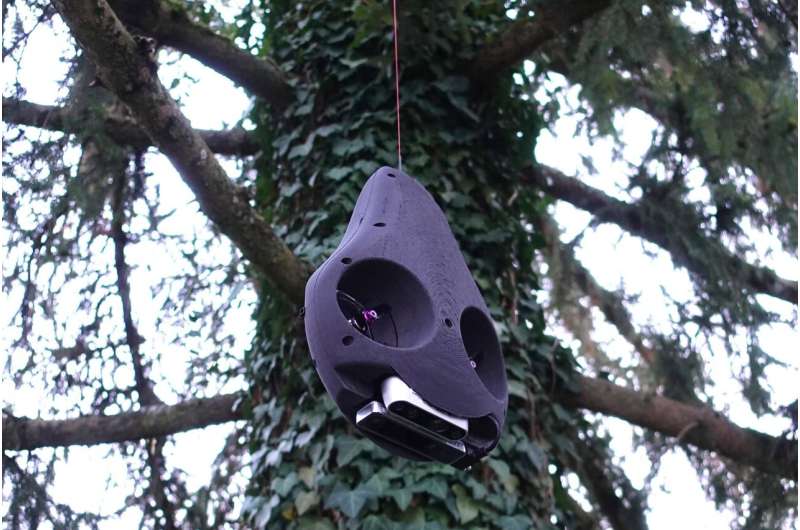This article has been reviewed according to Science X's editorial process and policies. Editors have highlighted the following attributes while ensuring the content's credibility:
fact-checked
peer-reviewed publication
trusted source
proofread
Avocado robot swings its way to unexplored treetops

It abseils from a height and swings around obstacles: Robot Avocado will one day maneuver through the canopy of the rainforest and collect data for researchers about this hard-to-reach habitat.
The innovative robot, Avocado, has a robust housing similar in shape to the green fruit. Concealed within it is the technology that will enable the robot to navigate through the treetops autonomously.
Avocado is one of the latest inventions in the field of environmental robotics.
"The idea behind this area of research is to get robots out of the factories and use them outdoors for environmental research," explains Steffen Kirchgeorg, a doctoral student at ETH Zurich and the Swiss Federal Institute for Forest, Snow and Landscape Research in Birmensdorf.
Especially in tropical rainforests—the world's most biodiverse habitats—it's in the dense canopy that the greatest number of living organisms are active. Exploring these habitats is extremely difficult; climbing the trees only allows research teams to collect data selectively.
For the existing robots, this environment is challenging too. Airborne drones are unsuitable as their rotor blades would get tangled up in the foliage, and the varying thicknesses and textures of branches present a challenge to climbing robots.
Like a spider on a thread
"That's why we came up with the idea of trying to gain access from above," Kirchgeorg explains. The robot is tethered by a cable to one of the top branches of a tree and is lowered from there into the tree's crown.
The researchers came upon this idea by observing spiders, which also abseil on their silk threads. In the current test phase, the researchers are still tethering the robot manually by climbing up the tree. Later, a drone could also serve as a kind of mothership, transporting the robot to inaccessible areas and anchoring it in the uppermost branches of the trees.
Once attached to the tree, Avocado can move up and down on its own—thanks to a winch that is tucked away in the upper section of its housing. Within its "bulge"—the part where the stone of a real avocado would be situated—the robot has two rotors. It uses them to gain momentum and maneuver around branches, foliage and other obstacles.
Together with colleagues from Stefano Mintchev's research group, Kirchgeorg has carried out simulations to see how the robot can move around autonomously through the skillful use of its winch and its rotors. Their research is published in the journal IEEE Transactions on Robotics.
The robot receives information about its environment from an integrated camera. But it's not as simple as that—as Kirchgeorg explains, "Lighting conditions in the treetops are very difficult, with light and dark alternating in quick succession. So we're now trying to get the camera to convey a perception of depth even under these conditions."
But the robot has already negotiated a predefined indoor obstacle course and has also survived a test run in a real tree.
Where no one else can go
Once Avocado has fully mastered autonomous locomotion, Kirchgeorg can imagine it being used in the rainforest for a longer duration. By remaining tethered, the robot will only use up battery power when it has to move—and it might be possible to transmit electricity down the cable from a solar cell mounted above. Moreover, the robot works so quietly that there's no risk of disturbing the tree's inhabitants.
Being tethered by a cable has another advantage: As the robot can carry quite a lot of weight, it can be equipped with plenty of instruments—e.g. humidity and temperature sensors to map the microclimate in different sections of the tree canopy, or gripper arms and air filters for collecting DNA samples.
"We might even discover some new animal or plant species," says Kirchgeorg. A large number of previously undiscovered species are probably still hiding in the canopy of the rainforest.
With Avocado and various other research activities, the team—working jointly with other ETH research groups—has made it to the finals of the "XPRIZE Rainforest" competition, which carries a substantial cash prize.
The foundation behind the competition awards the prize for innovations that will accelerate the monitoring of biodiversity in tropical rainforests. Time is of the essence, as more and more rainforests—and with them valuable habitat—are falling victim to agriculture and deforestation.
More information: Steffen Kirchgeorg et al, Design, Modeling, and Control of AVOCADO: A Multimodal Aerial-Tethered Robot for Tree Canopy Exploration, IEEE Transactions on Robotics (2023). DOI: 10.1109/TRO.2023.3334630
















